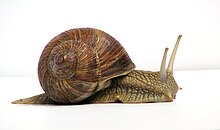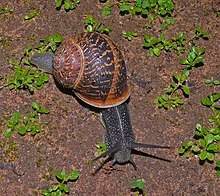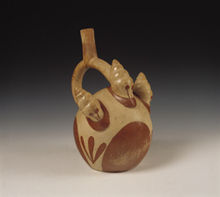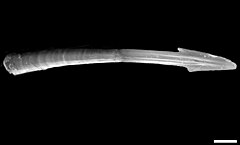Snail
| Snail | |
|---|---|

| |
| Helix pomatia, a species of land snail | |
| Scientific classification | |
| Kingdom: | |
| Phylum: | |
| Class: | |

Snail is a common name loosely applied to shelled gastropods. The name is most often applied to land snails, terrestrial pulmonate gastropod molluscs. However, the common name snail is also used for most of the members of the molluscan class Gastropoda that have a coiled shell that is large enough for the animal to retract completely into. When the word "snail" is used in this most general sense, it includes not just land snails but also numerous species of sea snails and freshwater snails. Gastropods that naturally lack a shell, or have only an internal shell, are mostly called slugs, and land snails that have only a very small shell (that they cannot retract into) are often called semi-slugs.
Snails have considerable human relevance, including as food items, as pests, as vectors of disease, and their shells are used as decorative objects and are incorporated into jewelry. The snail has also had some cultural significance, and has been used as a metaphor.
Overview
Snails that respire using a lung belong to the group Pulmonata. As traditionally defined, the Pulmonata were found to be polyphyletic in a molecular study per Jörger et al., dating from 2010.[1] But snails with gills also form a polyphyletic group; in other words, snails with lungs and snails with gills form a number of taxonomic groups that are not necessarily more closely related to each other than they are related to some other groups.
Both snails that have lungs and snails that have gills have diversified so widely over geological time that a few species with gills can be found on land and numerous species with lungs can be found in freshwater. Even a few marine species have lungs.
Snails can be found in a very wide range of environments, including ditches, deserts, and the abyssal depths of the sea. Although land snails may be more familiar to laymen, marine snails constitute the majority of snail species, and have much greater diversity and a greater biomass. Numerous kinds of snail can also be found in fresh water.
Most snails have thousands of microscopic tooth-like structures located on a banded ribbon-like tongue called a radula. The radula works like a file, ripping food into small pieces. Many snails are herbivorous, eating plants or rasping algae from surfaces with their radulae, though a few land species and many marine species are omnivores or predatory carnivores. Snails cannot absorb colored pigments when eating paper or cardboard so their feces are also colored.[2]
Several species of the genus Achatina and related genera are known as giant African land snails; some grow to 15 in (38 cm) from snout to tail, and weigh 1 kg (2 lb).[3] The largest living species of sea snail is Syrinx aruanus; its shell can measure up to 90 cm (35 in) in length, and the whole animal with the shell can weigh up to 18 kg (40 lb).
The snail Lymnaea makes decisions by using only two types of neuron: one deciding whether the snail is hungry, and the other deciding whether there is food in the vicinity.[4]
The largest known land gastropod is the African giant snail Achatina achatina, the largest recorded specimen of which measured 39.3 centimetres (15.5 in) from snout to tail when fully extended, with a shell length of 27.3 cm (10.7 in) in December 1978. It weighed exactly 900 g (2 lb). Named Gee Geronimo, this snail was owned by Christopher Hudson (1955–79) of Hove, East Sussex, UK, and was collected in Sierra Leone in June 1976.[5]
Types of snails by habitat
Slugs
This section relies largely or entirely on a single source. (March 2018) |
Gastropods that lack a conspicuous shell are commonly called slugs rather than snails.[6] Some species of slug have a red shell, some have only an internal vestige that serves mainly as a calcium repository, and others have no shell at all. Other than that there is little morphological difference between slugs and snails. There are however important differences in habitats and behavior.
A shell-less animal is much more maneuverable and compressible, so even quite large land slugs can take advantage of habitats or retreats with very little space, retreats that would be inaccessible to a similar-sized snail. Slugs squeeze themselves into confined spaces such as under loose bark on trees or under stone slabs, logs or wooden boards lying on the ground. In such retreats they are in less danger from either predators or desiccation, and often those also are suitable places for laying their eggs.
Slugs as a group are far from monophyletic; biologically speaking "slug" is a term of convenience with little taxonomic significance. The reduction or loss of the shell has evolved many times independently within several very different lineages of gastropods. The various taxa of land and sea gastropods with slug morphology occur within numerous higher taxonomic groups of shelled species; such independent slug taxa are not in general closely related to one another.
Human relevance
This section needs additional citations for verification. (March 2018) |

Land snails are known as an agricultural and garden pest but some species are an edible delicacy and occasionally household pets.
In agriculture
There are a variety of snail-control measures that gardeners and farmers use in an attempt to reduce damage to valuable plants. Traditional pesticides are still used, as are many less toxic control options such as concentrated garlic or wormwood solutions. Copper metal is also a snail repellent, and thus a copper band around the trunk of a tree will prevent snails from climbing up and reaching the foliage and fruit. Placing crushed egg shells on the soil around garden plants can also deter snails from coming to the plants.[citation needed]
The decollate snail (Rumina decollata) will capture and eat garden snails, and because of this it has sometimes been introduced as a biological pest control agent. However, this is not without problems, as the decollate snail is just as likely to attack and devour other gastropods that may represent a valuable part of the native fauna of the region.
As food

In French cuisine, edible snails are served for instance in Escargot à la Bourguignonne. The practice of rearing snails for food is known as heliciculture. For purposes of cultivation, the snails are kept in a dark place in a wired cage with dry straw or dry wood. Coppiced wine-grape vines are often used for this purpose. During the rainy period, the snails come out of hibernation and release most of their mucus onto the dry wood/straw. The snails are then prepared for cooking. Their texture when cooked is slightly chewy.
As well as being relished as gourmet food, several species of land snails provide an easily harvested source of protein to many people in poor communities around the world. Many land snails are valuable because they can feed on a wide range of agricultural wastes, such as shed leaves in banana plantations. In some countries, giant African land snails are produced commercially for food.
Land snails, freshwater snails and sea snails are all eaten in a number of countries (principally Spain, Philippines, Morocco, Nigeria, Algeria, Cameroon, France, Italy, Portugal, Greece, Bulgaria, Belgium, Vietnam, Laos, Cambodia, Cyprus, Ghana, Malta, Terai of Nepal, China, Northeast India states such as Manipur, Tripura and parts of the United States). In certain parts of the world, snails are fried. For example, in Indonesia, they are fried as satay, a dish known as sate kakul. The eggs of certain snail species are eaten in a fashion similar to the way caviar is eaten.
In Bulgaria, snails are traditionally cooked in an oven with rice or fried in a pan with vegetable oil and red paprika powder. Before they are used for those dishes, however, they are thoroughly boiled in hot water (for up to 90 minutes) and manually extracted from their shells. The two species most commonly used for food in the country are Helix lucorum and Helix pomatia.
Famine food
Snails and slug species that are not normally eaten in certain areas have occasionally been used as famine food in historical times. A history of Scotland written in the 1800s recounts a description of various snails and their use as food items in times of plague.[7]
Cosmetic
Skin creams derived from Helix aspersa snails are sold for use on wrinkles, scars, dry skin, and acne. A research study suggested that secretions produced under stress by Helix aspersa might facilitate regeneration of wounded tissue.[8]
Cultural depictions

Symbolism
Because of its slowness, the snail has traditionally been seen as a symbol of laziness. In Christian culture, it has been used as a symbol of the deadly sin of sloth.[9][10] Psalms 58:8 uses snail slime as a metaphorical punishment.
Divination and other religious uses

Snails were widely noted and used in divination.[9] The Greek poet Hesiod wrote that snails signified the time to harvest by climbing the stalks, while the Aztec moon god Tecciztecatl bore a snail shell on his back. This symbolised rebirth; the snail's penchant for appearing and disappearing was analogised with the moon.[11]
Love darts and Cupid

Professor Ronald Chase of McGill University in Montreal has suggested the ancient myth of Cupid's arrows might be based on early observations of the love dart behavior of the land snail species Helix aspersa.[12]
Metaphor
In contemporary speech, the expression "a snail's pace" is often used to describe a slow, inefficient process. The phrase "snail mail" is used to mean regular postal service delivery of paper messages as opposed to the delivery of email, which can be virtually instantaneous.
In Indonesian mythology

Keong Emas (Javanese and Indonesian for Golden Snail) is a popular Javanese folklore about a princess magically transformed and contained in a golden snail shell. The folklore is a part of popular Javanese Panji cycle telling the stories about the prince Panji Asmoro Bangun (also known as Raden Inu Kertapati) and his consort, princess Dewi Sekartaji (also known as Dewi Chandra Kirana).
Textiles
Certain varieties of snails, notably the family Muricidae, produce a secretion that is a color-fast natural dye. The ancient Tyrian purple was made in this way as were other purple and blue dyes.[13][14][15] The extreme expense of extracting this secretion is sufficient quantities limited its use to the very wealthy. It is such dyes as these that led to certain shades of purple and blue being associated with royalty and wealth.[16]
See also
References
- ^ Jörger, Katharina M; Stöger, Isabella; Kano, Yasunori; Fukuda, Hiroshi; Knebelsberger, Thomas; Schrödl, Michael (2010). "On the origin of Acochlidia and other enigmatic euthyneuran gastropods, with implications for the systematics of Heterobranchia". BMC Evolutionary Biology. 10 (1): 323. doi:10.1186/1471-2148-10-323. PMC 3087543. PMID 20973994.
{{cite journal}}: CS1 maint: unflagged free DOI (link) - ^ "Floor tiles made of coloured snail poo by Lieske Schreuder - design". 26 November 2013. Retrieved 29 March 2018.
- ^ Fredericks, Anthony D. (2010). How Long Things Live & How They Live As Long As They Do. Stackpole Books. p. 73. ISBN 9780811736220. Retrieved 19 June 2012.
- ^ Crossley, Michael; Staras, Kevin; Kemenes, György (3 June 2016). "A two-neuron system for adaptive goal-directed decision-making in Lymnaea". Nature Communications. 7: 11793. Bibcode:2016NatCo...711793C. doi:10.1038/ncomms11793. PMC 4895806. PMID 27257106.
- ^ "Largest Snail". Guinness World Records. Retrieved 17 December 2016.
- ^ "Slug vs Snail - Difference and Comparison - Diffen". Retrieved 29 March 2018.
- ^ Chambers, Robert (1858). Domestic annals of Scotland, from the reformation to the revolution. W. & R. Chambers. (Also quoted here.
- ^ Brieva, A.; Philips, N.; Tejedor, R.; Guerrero, A.; Pivel, J. P.; Alonso-Lebrero, J. L.; Gonzalez, S. (January 2008). "Molecular basis for the regenerative properties of a secretion of the mollusk Cryptomphalus aspersa". Skin Pharmacology and Physiology. 21 (1): 15–21. doi:10.1159/000109084. ISSN 1660-5527. PMID 17912020.
- ^ a b de Vries, Ad (1976). Dictionary of Symbols and Imagery. Amsterdam: North-Holland Publishing Company. p. 430. ISBN 978-0-7204-8021-4.
- ^ Tresidder, Jack (2006). Symbols and Their Meanings. New York: Barnes & Noble. p. 41. ISBN 978-0-7607-8164-7.
- ^ Cooper, J. C. (1992). Symbolic and Mythological Animals. London: Aquarian Press. p. 213. ISBN 978-1-85538-118-6.
- ^ Mayell, Hillary (February 13, 2004). "Lovebirds and Love Darts: The Wild World of Mating". news.national-geographic.com. National Geographic Society. Retrieved 2010-02-21.
- ^ Ziderman, I. I. (1986). "Purple dye made from shellfish in antiquity". Review of Progress in Coloration. 16: 46–52. ISSN 1472-3581.
- ^ Biggam, Carole P. (March 2006). "Whelks and purple dye in Anglo-Saxon England" (PDF). The Archeo+Malacology Group Newsletter (9).
- ^ Moorey, Peter (1999). Ancient Mesopotamian Materials and Industries: The Archaeological Evidence. Winona Lake, Indiana: Eisenbrauns. p. 138. ISBN 978-1-57506-042-2.
- ^ Nuttall, Zelia (1909). "A Curious Survival in Mexico of the Use of the Purpura Shell-fish for Dyeing". In Boas, Franz (ed.). Putnam Anniversary Volume. Vol. Anthropological Essays Presented to Fredrick Ward Putnam in Honor of his Seventieth Birthday, by his Friends and Associates. New York: G. E. Stechert & Co. pp. 368–384. LCCN 10011191.
External links
- Introduction to Snails, Infoqis Publishing, Co.
